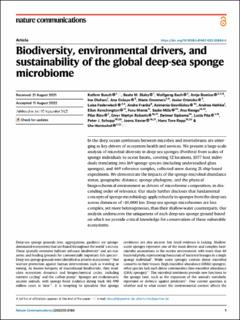| dc.contributor.author | Busch, Kathrin | |
| dc.contributor.author | Slaby, Beate M. | |
| dc.contributor.author | Bach, Wolfgang | |
| dc.contributor.author | Boetius, Antje | |
| dc.contributor.author | Clefsen, Ina | |
| dc.contributor.author | Colaço, Ana | |
| dc.contributor.author | Creemers, Marie | |
| dc.contributor.author | Cristobo, Javier | |
| dc.contributor.author | Federwisch, Luisa | |
| dc.contributor.author | Franke, Andre | |
| dc.contributor.author | Gavriilidou, Asimenia | |
| dc.contributor.author | Hethke, Andrea | |
| dc.contributor.author | Kenchington, Ellen | |
| dc.contributor.author | Mienis, Furu | |
| dc.contributor.author | Mills, Sadie | |
| dc.contributor.author | Riesgo, Ana | |
| dc.contributor.author | Ríos, Pilar | |
| dc.contributor.author | Roberts, Emyr Martyn | |
| dc.contributor.author | Sipkema, Detmer | |
| dc.contributor.author | Pita, Lucía | |
| dc.contributor.author | Schupp, Peter J. | |
| dc.contributor.author | Xavier, Joana R. | |
| dc.contributor.author | Rapp, Hans Tore | |
| dc.contributor.author | Hentschel, Ute | |
| dc.date.accessioned | 2022-11-21T15:27:42Z | |
| dc.date.available | 2022-11-21T15:27:42Z | |
| dc.date.created | 2022-11-09T13:06:35Z | |
| dc.date.issued | 2022 | |
| dc.identifier.issn | 2041-1723 | |
| dc.identifier.uri | https://hdl.handle.net/11250/3033219 | |
| dc.description.abstract | In the deep ocean symbioses between microbes and invertebrates are emerging as key drivers of ecosystem health and services. We present a large-scale analysis of microbial diversity in deep-sea sponges (Porifera) from scales of sponge individuals to ocean basins, covering 52 locations, 1077 host individuals translating into 169 sponge species (including understudied glass sponges), and 469 reference samples, collected anew during 21 ship-based expeditions. We demonstrate the impacts of the sponge microbial abundance status, geographic distance, sponge phylogeny, and the physical-biogeochemical environment as drivers of microbiome composition, in descending order of relevance. Our study further discloses that fundamental concepts of sponge microbiology apply robustly to sponges from the deep-sea across distances of >10,000 km. Deep-sea sponge microbiomes are less complex, yet more heterogeneous, than their shallow-water counterparts. Our analysis underscores the uniqueness of each deep-sea sponge ground based on which we provide critical knowledge for conservation of these vulnerable ecosystems. | en_US |
| dc.language.iso | eng | en_US |
| dc.publisher | Springer Nature | en_US |
| dc.rights | Navngivelse 4.0 Internasjonal | * |
| dc.rights.uri | http://creativecommons.org/licenses/by/4.0/deed.no | * |
| dc.title | Biodiversity, environmental drivers, and sustainability of the global deep-sea sponge microbiome | en_US |
| dc.type | Journal article | en_US |
| dc.type | Peer reviewed | en_US |
| dc.description.version | publishedVersion | en_US |
| dc.rights.holder | Copyright 2022 the authors | en_US |
| dc.source.articlenumber | 5160 | en_US |
| cristin.ispublished | true | |
| cristin.fulltext | original | |
| cristin.qualitycode | 2 | |
| dc.identifier.doi | 10.1038/s41467-022-32684-4 | |
| dc.identifier.cristin | 2071232 | |
| dc.source.journal | Nature Communications | en_US |
| dc.identifier.citation | Nature Communications. 2022, 13, 5160. | en_US |
| dc.source.volume | 13 | en_US |

